1986 TOYOTA CAMRY V20 belt
[x] Cancel search: beltPage 1180 of 2389

The 3S±FE engine is an in±line 4±cylinder engine with the cylinders numbered 1 ± 2 ± 3 ± 4 from the
front.
The crankshaft is supported by 5 bearing inside the crankcase. These bearing are made of aluminum
alloy.
The crankshaft is integrated with 8 weights for balance. Oil holes are placed in the center of the crank-
shaft to supply oil to the connecting rods, bearing, pistons and other components.
This engine's ignition order is 1 ± 3 ± 4 ± 2. The cylinder head is made of aluminum alloy, with a cross
flow type intake and exhaust layout and with pent±roof type combustion chambers. The spark plugs are
located in the center of the combustion chamber.
The intake manifold has 8 independent long ports and utilizes the inertial supercharging effect to im-
prove engine torque at low and medium speeds.
Exhaust and intake valves are equipped with irregular pitch springs made of special valve spring carbon
steel which are capable of functioning no matter what the engine speed.
The intake side camshaft is driven by a timing belt, and a gear on the intake side camshaft engages with
a gear on the exhaust side camshaft to drive it. The cam journal is supported at 5 places between the
valve lifters of each cylinder and on the front end of the cylinder head. Lubrication of the cam journal and
gear is accomplished by oil being supplied through the oiler port in the center of the camshaft.
Adjustment of the valve clearance is done by means of outer shim type system, in which valve adjusting
shims are located above the valve lifters. This permits replacement of the shims without removal of the
camshafts.
The resin timing belt cover is made of 2 pieces. A service hole is provided in the No. 1 belt cover for ad-
justing the timing belt tension.
Piston are made of high temperature±resistant aluminum alloy, and a depression is built into the piston
head to prevent interference with the valves.
Piston pins are the semi±floating type, with the pins fastened to the connecting rods by pressure fitting,
allowing the pistons and pins to float.
The No. 1 compression ring is made of steel and the No. 2 compression ring is made of cast iron. The oil
ring is made of a combination of steel and stainless steel. The outer diameter of each piston ring is
slightly larger than the diameter of the piston and the flexibility of the rings allows them to hug the cylin-
der walls when they are mounted on the piston rings No. 1 and No. 2 work to prevent gas leakage from
the cylinder and oil ring works to clear oil off the cylinder walls to prevent it from entering the combustion
chambers.
The cylinder block is made of cast iron. It has 4 cylinders which are approximately 2 times the length of
the piston stroke. The top of the cylinders is closed off by the cylinder head and the lower end of the cyl-
inders becomes the crankcase, in which the crankshaft is installed. In .addition, the cylinder block con-
tains a water jacket, through which coolant is pumped to cool the cylinders.
The oil pan is bolted onto the bottom of the cylinder block. The oil pan is an oil reservoir made of
pressed steel shoot. A dividing plate is included inside the oil pan to keep sufficient oil in the bottom of
the pan even when the vehicle is tilted. This dividing plate also prevents the oil from making waves when
the vehicle is topped suddenly and thus shifting the oil away from the oil pump suction pipe.
± ENGINE MECHANICALDescription (3S±FE)EM±3
Page 1182 of 2389
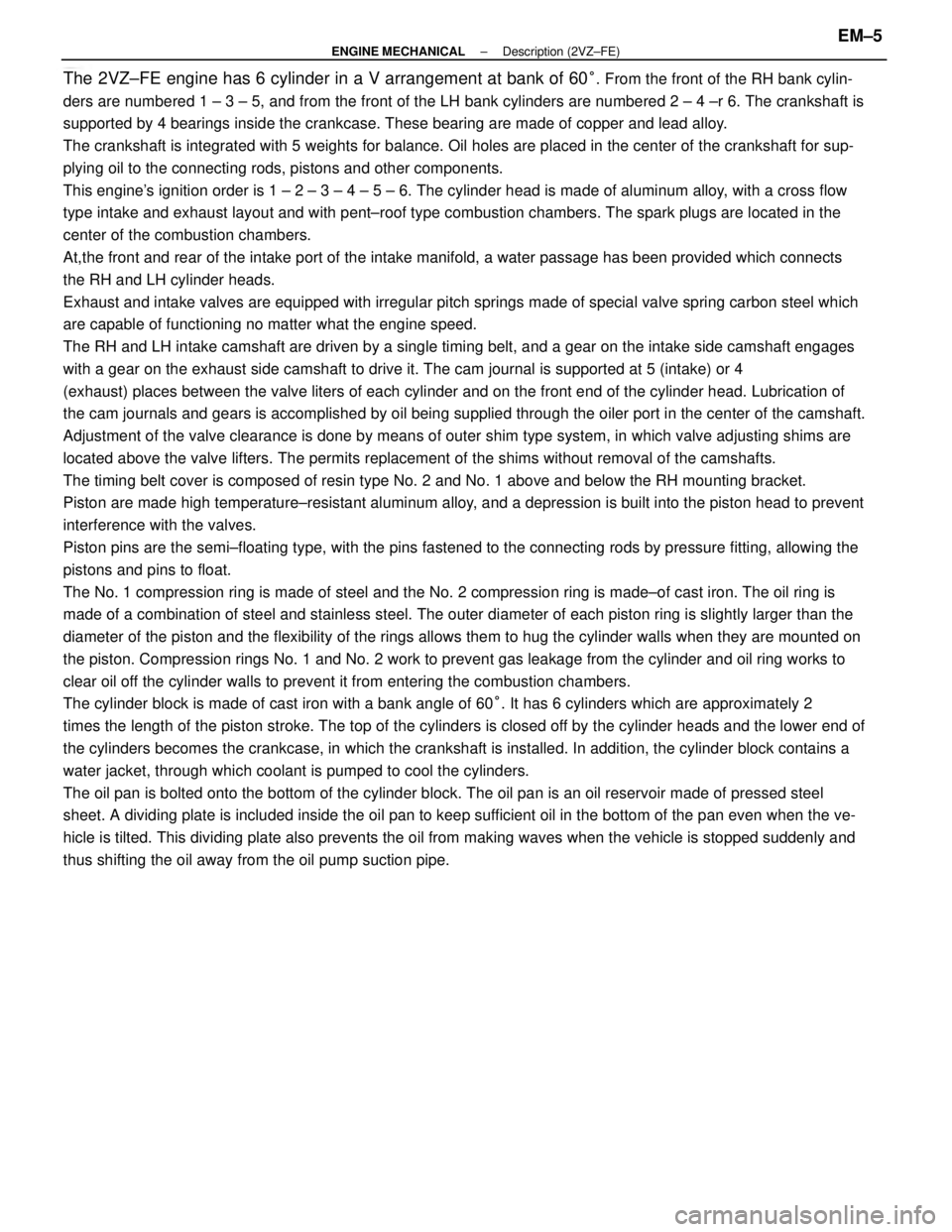
The 2VZ±FE engine has 6 cylinder in a V arrangement at bank of 60°. From the front of the RH bank cylin-
ders are numbered 1 ± 3 ± 5, and from the front of the LH bank cylinders are numbered 2 ± 4 ±r 6. The crankshaft is
supported by 4 bearings inside the crankcase. These bearing are made of copper and lead alloy.
The crankshaft is integrated with 5 weights for balance. Oil holes are placed in the center of the crankshaft for sup-
plying oil to the connecting rods, pistons and other components.
This engine's ignition order is 1 ± 2 ± 3 ± 4 ± 5 ± 6. The cylinder head is made of aluminum alloy, with a cross flow
type intake and exhaust layout and with pent±roof type combustion chambers. The spark plugs are located in the
center of the combustion chambers.
At,the front and rear of the intake port of the intake manifold, a water passage has been provided which connects
the RH and LH cylinder heads.
Exhaust and intake valves are equipped with irregular pitch springs made of special valve spring carbon steel which
are capable of functioning no matter what the engine speed.
The RH and LH intake camshaft are driven by a single timing belt, and a gear on the intake side camshaft engages
with a gear on the exhaust side camshaft to drive it. The cam journal is supported at 5 (intake) or 4
(exhaust) places between the valve liters of each cylinder and on the front end of the cylinder head. Lubrication of
the cam journals and gears is accomplished by oil being supplied through the oiler port in the center of the camshaft.
Adjustment of the valve clearance is done by means of outer shim type system, in which valve adjusting shims are
located above the valve lifters. The permits replacement of the shims without removal of the camshafts.
The timing belt cover is composed of resin type No. 2 and No. 1 above and below the RH mounting bracket.
Piston are made high temperature±resistant aluminum alloy, and a depression is built into the piston head to prevent
interference with the valves.
Piston pins are the semi±floating type, with the pins fastened to the connecting rods by pressure fitting, allowing the
pistons and pins to float.
The No. 1 compression ring is made of steel and the No. 2 compression ring is made±of cast iron. The oil ring is
made of a combination of steel and stainless steel. The outer diameter of each piston ring is slightly larger than the
diameter of the piston and the flexibility of the rings allows them to hug the cylinder walls when they are mounted on
the piston. Compression rings No. 1 and No. 2 work to prevent gas leakage from the cylinder and oil ring works to
clear oil off the cylinder walls to prevent it from entering the combustion chambers.
The cylinder block is made of cast iron with a bank angle of 60°. It has 6 cylinders which are approximately 2
times the length of the piston stroke. The top of the cylinders is closed off by the cylinder heads and the lower end of
the cylinders becomes the crankcase, in which the crankshaft is installed. In addition, the cylinder block contains a
water jacket, through which coolant is pumped to cool the cylinders.
The oil pan is bolted onto the bottom of the cylinder block. The oil pan is an oil reservoir made of pressed steel
sheet. A dividing plate is included inside the oil pan to keep sufficient oil in the bottom of the pan even when the ve-
hicle is tilted. This dividing plate also prevents the oil from making waves when the vehicle is stopped suddenly and
thus shifting the oil away from the oil pump suction pipe.
± ENGINE MECHANICALDescription (2VZ±FE)EM±5
Page 1187 of 2389
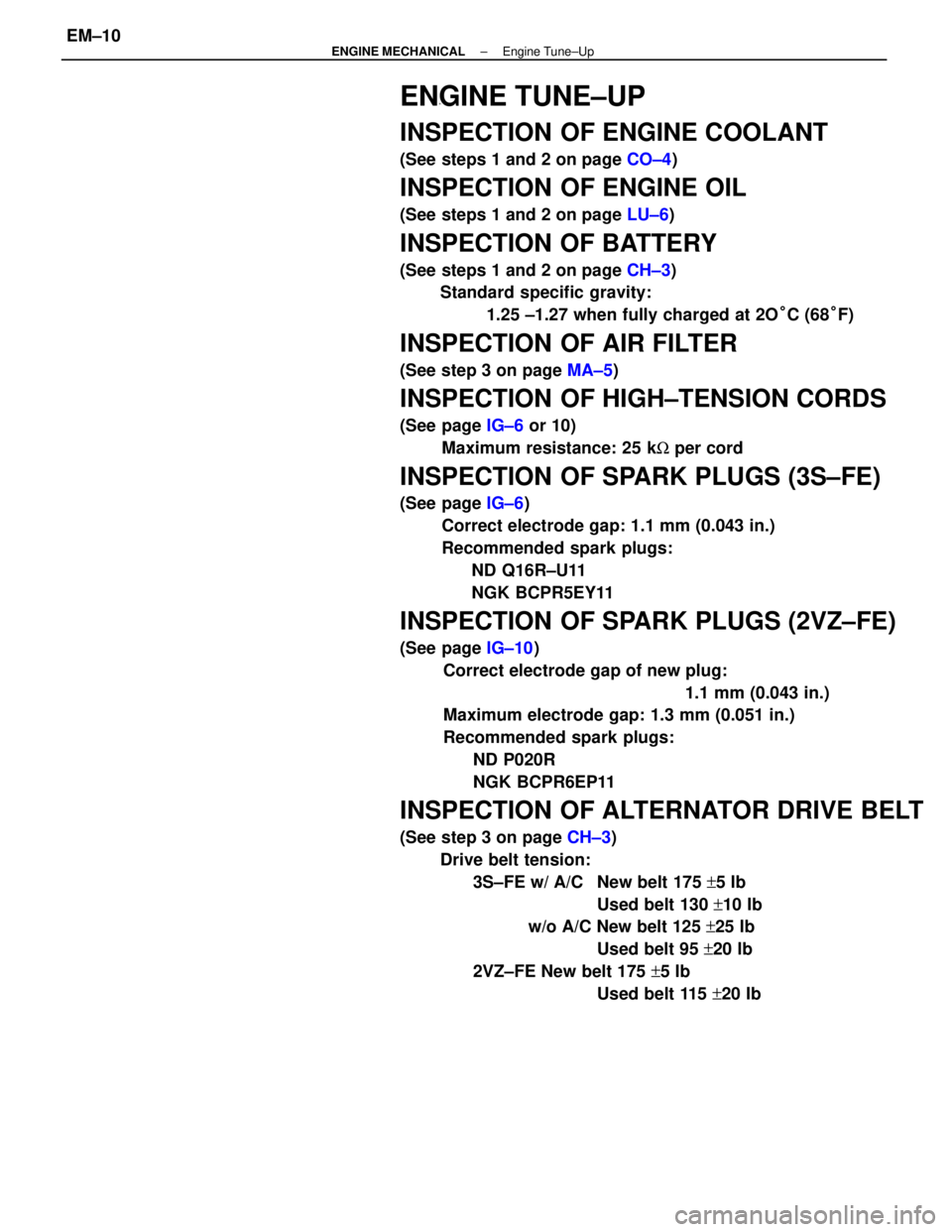
ENGINE TUNE±UP
INSPECTION OF ENGINE COOLANT
(See steps 1 and 2 on page CO±4)
INSPECTION OF ENGINE OIL
(See steps 1 and 2 on page LU±6)
INSPECTION OF BATTERY
(See steps 1 and 2 on page CH±3)
Standard specific gravity:
1.25 ±1.27 when fully charged at 2O°C (68°F)
INSPECTION OF AIR FILTER
(See step 3 on page MA±5)
INSPECTION OF HIGH±TENSION CORDS
(See page IG±6 or 10)
Maximum resistance: 25 kW per cord
INSPECTION OF SPARK PLUGS (3S±FE)
(See page IG±6)
Correct electrode gap: 1.1 mm (0.043 in.)
Recommended spark plugs:
ND Q16R±U11
NGK BCPR5EY11
INSPECTION OF SPARK PLUGS (2VZ±FE)
(See page IG±10)
Correct electrode gap of new plug:
1.1 mm (0.043 in.)
Maximum electrode gap: 1.3 mm (0.051 in.)
Recommended spark plugs:
ND P020R
NGK BCPR6EP11
INSPECTION OF ALTERNATOR DRIVE BELT
(See step 3 on page CH±3)
Drive belt tension:
3S±FE w/ A/C New belt 175 +5 Ib
Used belt 130 +10 Ib
w/o A/C New belt 125 +25 Ib
Used belt 95 +20 Ib
2VZ±FE New belt 175 +5 Ib
Used belt 115 +20 Ib
± ENGINE MECHANICALEngine Tune±UpEM±10
Page 1188 of 2389
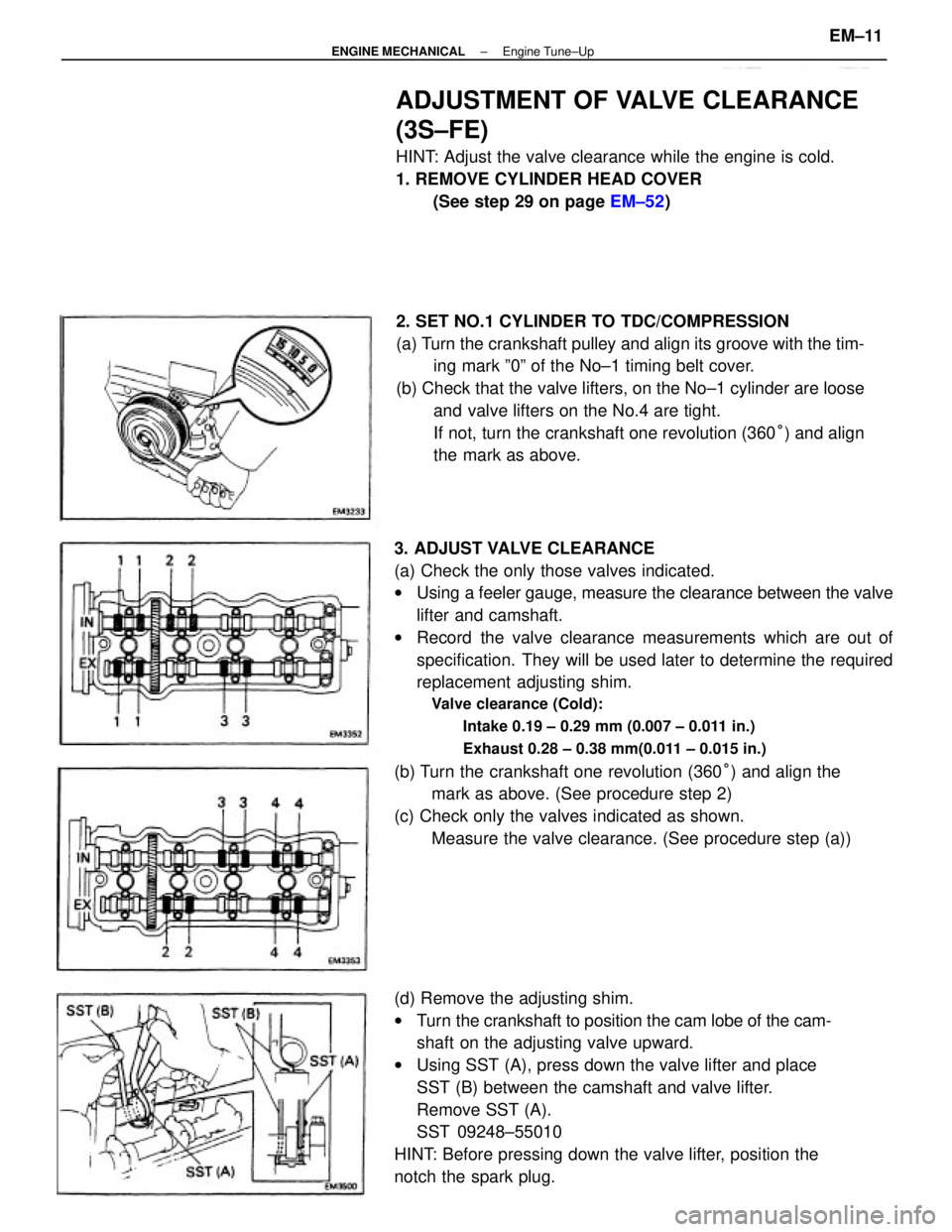
3. ADJUST VALVE CLEARANCE
(a) Check the only those valves indicated.
wUsing a feeler gauge, measure the clearance between the valve
lifter and camshaft.
wRecord the valve clearance measurements which are out of
specification. They will be used later to determine the required
replacement adjusting shim.
Valve clearance (Cold):
Intake 0.19 ± 0.29 mm (0.007 ± 0.011 in.)
Exhaust 0.28 ± 0.38 mm(0.011 ± 0.015 in.)
(b) Turn the crankshaft one revolution (360°) and align the
mark as above. (See procedure step 2)
(c) Check only the valves indicated as shown.
Measure the valve clearance. (See procedure step (a))
(d) Remove the adjusting shim.
wTurn the crankshaft to position the cam lobe of the cam-
shaft on the adjusting valve upward.
wUsing SST (A), press down the valve lifter and place
SST (B) between the camshaft and valve lifter.
Remove SST (A).
SST 09248±55010
HINT: Before pressing down the valve lifter, position the
notch the spark plug.2. SET NO.1 CYLINDER TO TDC/COMPRESSION
(a) Turn the crankshaft pulley and align its groove with the tim-
ing mark º0º of the No±1 timing belt cover.
(b) Check that the valve lifters, on the No±1 cylinder are loose
and valve lifters on the No.4 are tight.
If not, turn the crankshaft one revolution (360°) and align
the mark as above.
ADJUSTMENT OF VALVE CLEARANCE
(3S±FE)
HINT: Adjust the valve clearance while the engine is cold.
1. REMOVE CYLINDER HEAD COVER
(See step 29 on page EM±52)
± ENGINE MECHANICALEngine Tune±UpEM±11
Page 1192 of 2389

4. ADJUST VALVE CLEARANCE
(a) Check only those valves indicated in the figure.
wUsing a feeler gauge, measure the clearance between the
valve lifter and camshaft.
wRecord the valve clearance measurements which are out of
specification. They will be used later to determine the re-
quired replacement adjusting shim.
Valve clearance (Cold):
Intake 0.13 ± 0:23 mm (0.005 ± 0.009 in.)
Exhaust 0.27 ± 0.37 mm (0.011 ± 0.015 in.)
(b) Turn the crankshaft 2/3 of a revolution (240°), and check only
the valves indicated in the figure.
Measure the valve clearance.
(See procedure step W)
ADJUSTMENT OF VALVE CLEARANCE
(2VZ±FE)
HINT: Adjust the valve clearance while the engine is cold.
1. REMOVE AIR INTAKE CHAMBER
(See steps 1 to 21 on page FI±76 and 77)
2. REMOVE CYLINDER HEAD COVERS
(See step 32 on page EM±80)
3. SET NO.1 CYLINDER TO TDCI COMPRESSION
(a) Turn the crankshaft pulley, and align its groove with the tim-
ing mark º0º of the No.1 timing belt cover.
(b) Check that the valve lifters on the No. 1 (IN) are loose
and valve lifters on the No.1 (EX) are tight.
If not, turn the crankshaft one revolution (360
°) and align the
mark as above.
(c) Turn the crankshaft a further 2I3 of a revolution
(240°), and check only the valves indicated in the fig-
ure.
Measure the valve clearance.
(See procedure step (a))
± ENGINE MECHANICALEngine Tune±UpEM±15
Page 1200 of 2389
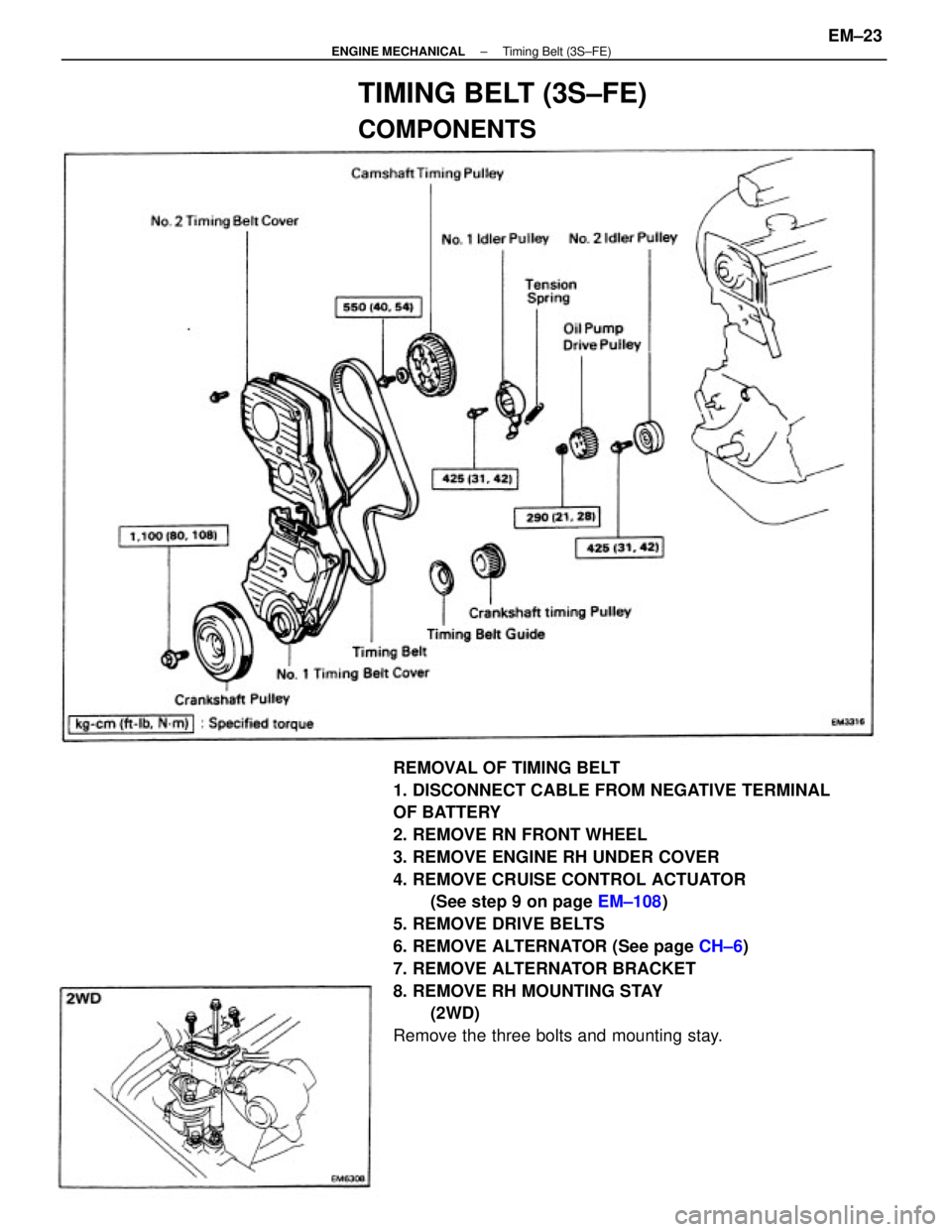
REMOVAL OF TIMING BELT
1. DISCONNECT CABLE FROM NEGATIVE TERMINAL
OF BATTERY
2. REMOVE RN FRONT WHEEL
3. REMOVE ENGINE RH UNDER COVER
4. REMOVE CRUISE CONTROL ACTUATOR
(See step 9 on page EM±108)
5. REMOVE DRIVE BELTS
6. REMOVE ALTERNATOR (See page CH±6)
7. REMOVE ALTERNATOR BRACKET
8. REMOVE RH MOUNTING STAY
(2WD)
Remove the three bolts and mounting stay.
TIMING BELT (3S±FE)
COMPONENTS
± ENGINE MECHANICALTiming Belt (3S±FE)EM±23
Page 1201 of 2389
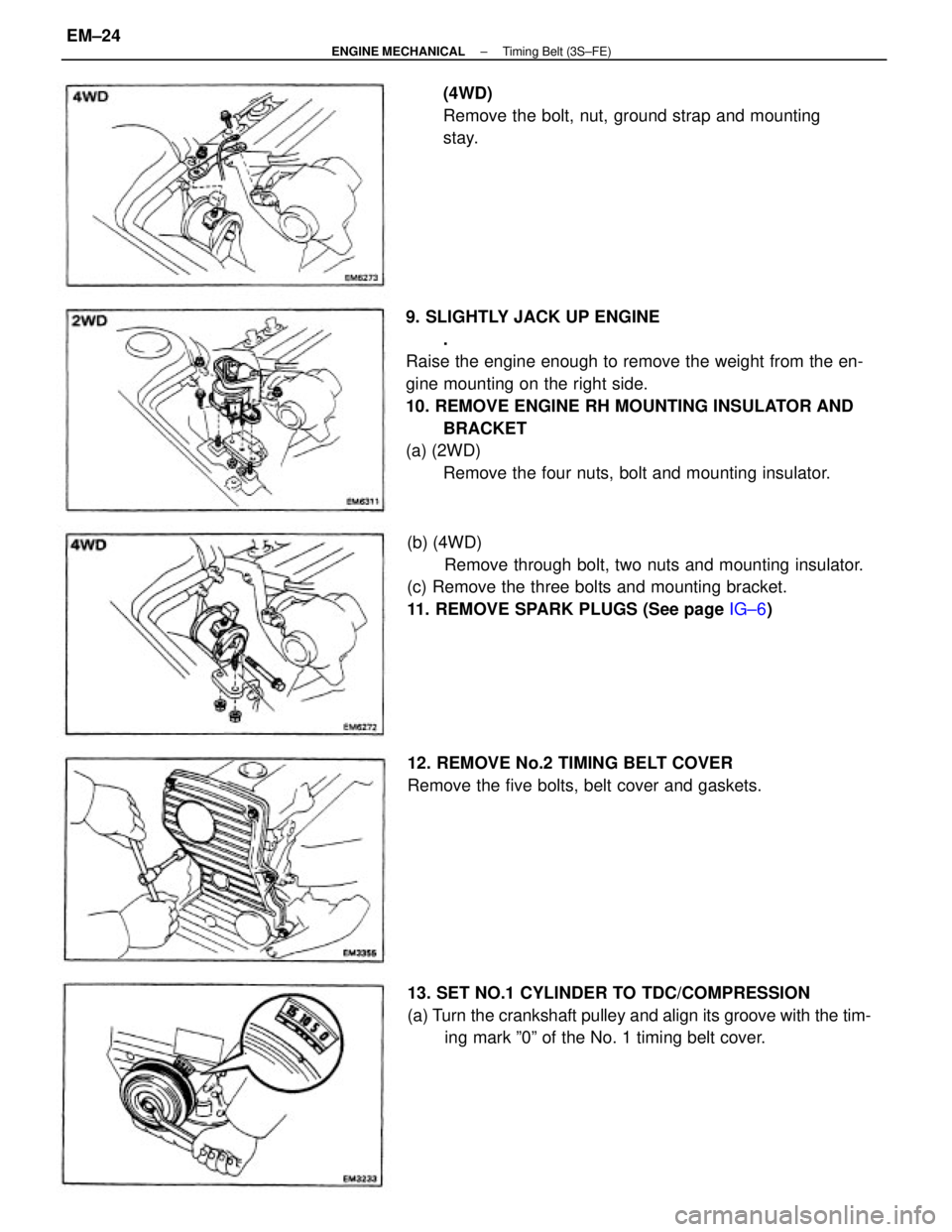
9. SLIGHTLY JACK UP ENGINE
.
Raise the engine enough to remove the weight from the en-
gine mounting on the right side.
10. REMOVE ENGINE RH MOUNTING INSULATOR AND
BRACKET
(a) (2WD)
Remove the four nuts, bolt and mounting insulator.
(b) (4WD)
Remove through bolt, two nuts and mounting insulator.
(c) Remove the three bolts and mounting bracket.
11. REMOVE SPARK PLUGS (See page IG±6)
13. SET NO.1 CYLINDER TO TDC/COMPRESSION
(a) Turn the crankshaft pulley and align its groove with the tim-
ing mark º0º of the No. 1 timing belt cover. (4WD)
Remove the bolt, nut, ground strap and mounting
stay.
12. REMOVE No.2 TIMING BELT COVER
Remove the five bolts, belt cover and gaskets.
± ENGINE MECHANICALTiming Belt (3S±FE)EM±24
Page 1202 of 2389
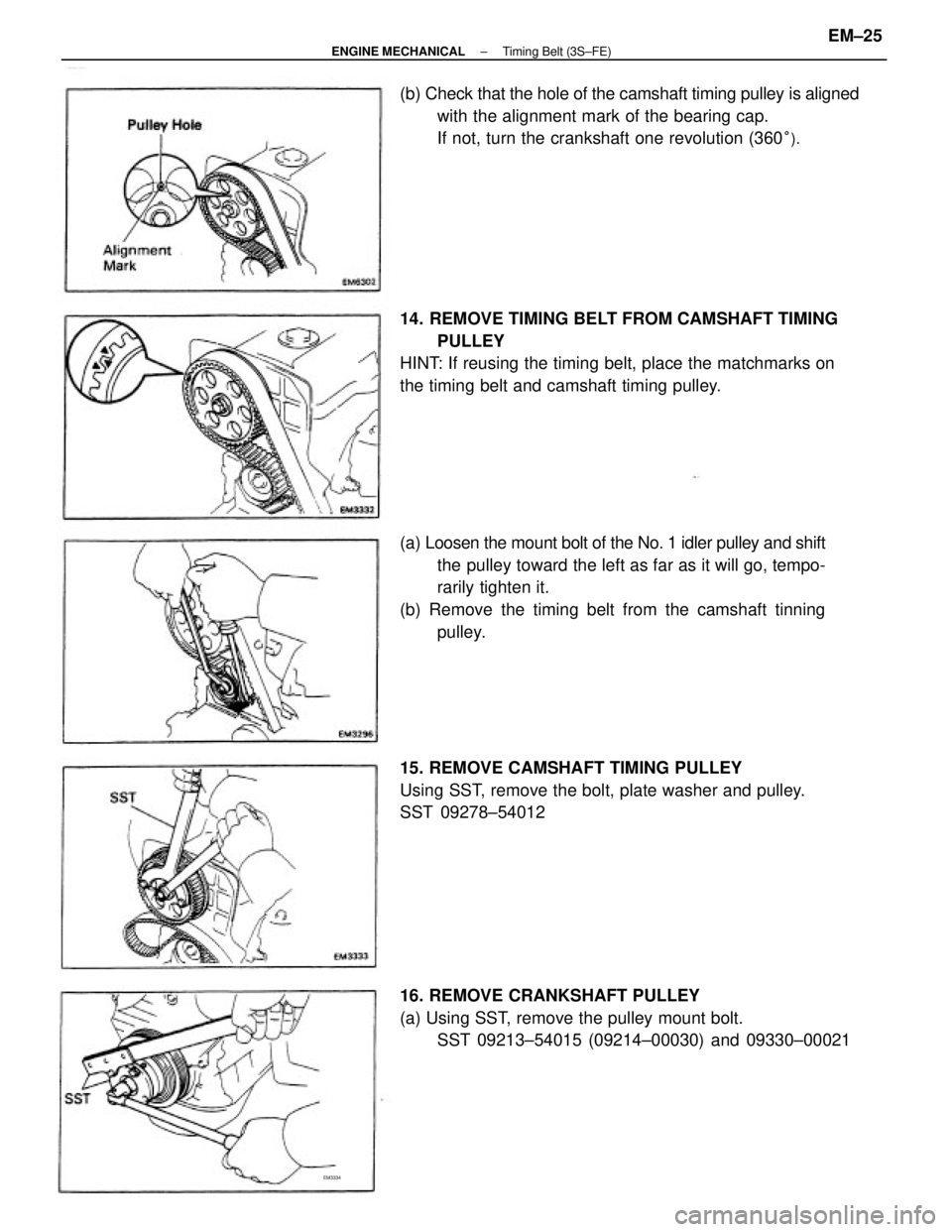
(a) Loosen the mount bolt of the No. 1 idler pulley and shift
the pulley toward the left as far as it will go, tempo-
rarily tighten it.
(b) Remove the timing belt from the camshaft tinning
pulley. 14. REMOVE TIMING BELT FROM CAMSHAFT TIMING
PULLEY
HINT: If reusing the timing belt, place the matchmarks on
the timing belt and camshaft timing pulley.
15. REMOVE CAMSHAFT TIMING PULLEY
Using SST, remove the bolt, plate washer and pulley.
SST 09278±54012
16. REMOVE CRANKSHAFT PULLEY
(a) Using SST, remove the pulley mount bolt.
SST 09213±54015 (09214±00030) and 09330±00021 (b) Check that the hole of the camshaft timing pulley is aligned
with the alignment mark of the bearing cap.
If not, turn the crankshaft one revolution (360
°).
EM3334
± ENGINE MECHANICALTiming Belt (3S±FE)EM±25